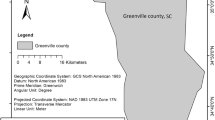Abstract
Development of economic way and increased population caused rapid changes to Earth’s land cover over the past few centuries and for sure these changes in land will be more rapid in time. Rapid changes in land cover affect the ability of the land to support human activities through the supply of various ecosystem services because the subsequent economic activities cause counter climate and other facets of worldwide change. To Deland cover languages in land covered faultlessly, a model that catches the changes between two date times is necessary. With satellite Natural Agricultural Imagery Project (NAIP) images, this study uses multi-spectral images of two timestamps to disclose land cover ranges over a piece of land. Detection of land cover changes can be done with the object-based classification of the area. Geospatial analysis is carried out through Google Earth Engine (GEE).
Access this chapter
Tax calculation will be finalised at checkout
Purchases are for personal use only
Similar content being viewed by others
References
Singh AI, Singh K (2021) Remote sensing and GIS based land use land cover analysis in Chandel district, Manipur, India. IOP Conf Ser Earth Environ Sci 889:012046
Casu F, Manunta M, Agram PS, Crippen RE (2017) Big remotely sensed data: tools, applications and experiences. Remote Sens Environ 202:1–2
Sathunuri K, Kumar R, Gogoi K (2022) Land use/land cover dynamics during 2001 and 2021 using Google Earth Engine and GIS in ramagundam coal mining area, a part of Pranhita Godavari Valley, Southern India. J Sci Res 66:63–68
Harpinder S, Aarti K, Litoria PK, Brijendra (2021) Land cover classification of Punjab state using Sentinel-2 data and machine learning within the Google Earth engine cloud platform. J Geomatics 15(2):166–173
Dubertret F, Le Tourneau F-M, Villarreal ML, Norman LM (2022) Monitoring “annual land use/land cover change in the Tucson Metropolitan area with Google Earth Engine (1986–2020).” Remote Sens 14:2127
Loukika KN, Keesara VR, Sridhar V (2021) Analysis of land use and land cover using machine learning algorithms on google earth engine for Munneru River Basin, India. Sustainability 13(24)
Pech-May F, Aquino-Santos R, Rios-Toledo G, Posadas-Durán JPF (2022) Mapping of land cover with optical images, supervised algorithms, and Google Earth Engine. Sensors 22
Wulder MA, Coops NC, Roy DP, White JC, Hermosilla T (2018) Land cover 2.0. Int J Remote Sens 39:4254–4284
Kamaraj M, Rangarajan S (2022) Predicting the future land use and land cover changes for Bhavani basin, Tamil Nadu, India, using QGIS MOLUSCE plugin. Environ Sci Pollut Res 29:86337–86348
Tassi A, Vizzari M (2020) Object-oriented LULC classification in Google Earth Engine combining SNIC, GLCM, and machine learning algorithms. Remote Sens
Chen DM, Stow D (2002) The effect of training strategies on supervised classification at different spatial resolutions. Photogramm Eng Remote Sens 68:1155–1161
Xie S, Liu L, Zhang X, Yang J, Chen X, Gao Y (2019) “Automatic land-cover mapping using landsat time-series”, data based on google earth engine. Remote Sens 11:3023
Woodcock CE, Macomber SA, Kumar L (2010) Vegetation mapping and monitoring. In: Environmental modelling, with GIS and remote sensing. CRC Press, Boca Raton, FL, USA
Lunetta RS, Knight JF, Ediriwickrema J, Lyon JG, Worthy LD (2006) Land-cover change detection using multi-temporal MODIS NDVI data. Remote Sens Environ 105
Shalaby A, Tateishi R (2007) “Remote sensing and GIS for mapping and monitoring land cover and land-use”, changes in the Northwestern coastal zone of Egypt. Appl Geogr 27
Vizzari M, Sigura M (2015) “Landscape sequences along the urban–rural–natural gradient: a novel geospatial”, approach for identification and analysis. Landsc Urban Plan 140:42–55
Vizzari M, Hilal M, Sigura M, Antognelli S, Joly D (2018) “Urban-rural-natural gradient analysis with CORINE”, data: an application to the metropolitan France. Landsc Urban Plan 171
Pfeifer M, Disney M, Quaife T, Marchant R (2012) “Terrestrial ecosystems from space: a review of earth”, observation products for macroecology applications. Glob Ecol Biogeogr
Blaschke T (2010) Object based image analysis for remote sensing. ISPRS J Photogramm Remote Sens 65:2–16
Wang Y, Li Z, Zeng C, Xia G-S, Shen H (2020) An urban water extraction method combining deep learning and Google Earth Engine. IEEE J Sel Top Appl Earth Obs Remote Sens 13:769–782
MacLachlan A, Roberts G, Biggs E, Boruff B (2017) Subpixel land-cover classification for improved urban area estimates using Landsat. Int J Remote Sens 38:5763–5792
Verhoeye J, De Wulf R (2002) Land cover mapping at sub-pixel scales using linear optimization techniques. Remote Sens Environ 79:96–104
Radwan TM, Blackburn GA, Whyatt JD, Atkinson PM (2021) Global land cover trajectories and transitions. Sci Rep 11:12814
Dong C, Zhao G, Meng Y, Li B, Peng B (2020) The effect of topographic correction on forest tree species classification accuracy. Remote Sens 12:787
Kumar L, Mutanga O (2018) Google Earth Engine applications since inception: usage, trends, and potential. Remote Sens 10:1509
Author information
Authors and Affiliations
Corresponding author
Editor information
Editors and Affiliations
Rights and permissions
Copyright information
© 2024 The Author(s), under exclusive license to Springer Nature Singapore Pte Ltd.
About this paper
Cite this paper
Puligadda, P., Manne, S., Raja, D.R. (2024). Land Cover Changes Detection Based on Object-Based Image Classification Using the Google Earth Engine. In: Shrivastava, V., Bansal, J.C., Panigrahi, B.K. (eds) Power Engineering and Intelligent Systems. PEIS 2023. Lecture Notes in Electrical Engineering, vol 1098. Springer, Singapore. https://doi.org/10.1007/978-981-99-7383-5_22
Download citation
DOI: https://doi.org/10.1007/978-981-99-7383-5_22
Published:
Publisher Name: Springer, Singapore
Print ISBN: 978-981-99-7382-8
Online ISBN: 978-981-99-7383-5
eBook Packages: EnergyEnergy (R0)




